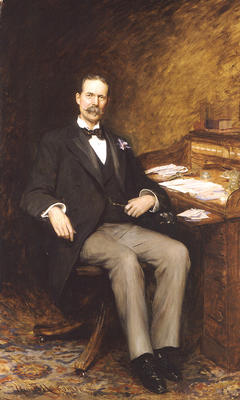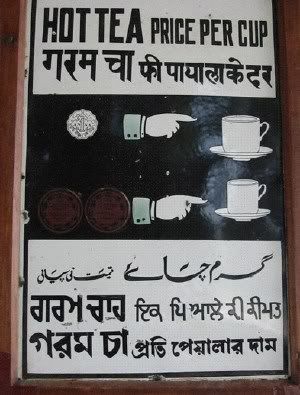I am sitting in front of my computer, listening to my favorite “Vital Signs” song:
Ye shaam phir nahi aaye gi
(This evening won’t come again)
I am smiling and sipping on my favorite Lipton Tea, while my fingers are keying in this moment in time.
All in all, a very coordinated effort is going on between my mind and soul. But take “Lipton tea” out of this equation and I’ll be left to a bored-to-death person listening to an archaic ancient group which historians remember by the name of ‘Vital Signs’ from early 90s and writing these disjointed words.
“Lipton Tea” – these two words stir deep memories in me. The earliest memory of Lipton tea in my life is drinking it with my maternal great grandfather (paR-nana).
 This portrait to the left, by the way, is of Sir Thomas J Lipton; not of my paR-nana!).
This portrait to the left, by the way, is of Sir Thomas J Lipton; not of my paR-nana!).
My great grand father was born in 1896 and lived till 1986. Until his last days he had a habit of making a cup of tea around 3 pm, and whenever I was around (which I always was) he used to pour some tea in my cup too. After that both of us would start watching PTV which started its daily transmission around 4 p.m. and sip on our tea.
Grandfather had migrated to Pakistan from India in 1947. He used to tell me all these great political stories from the old days, the Caliphate Movement, First World War, Quit-India Movement, Second World War, the Pakistan movement and finally the emergence of Pakistan.
He told me that until 1900s not many people in India knew about drinking tea (except for the tea growing areas of Darjeeling/Assam etc). British and whatever was left of East India Company at that time owned all the tea plantations in India, Ceylon (SriLanka), and Africa. Raw tea leaves were sent to London at Lipton Tea Company and after being processed and packed, was brought back to India and sold at exorbitant prices to the local people, on whose land the tea grew in first place.
Grand father told me that in the early 1900s Britishers used to set tea-stalls at street corners all over India and used to offer ‘free’ tea cups to Indians to promote the Lipton brand. In the beginning tea drinking was fashion at the high echelons of Indian society. Nawabs, and Rajas used to drink it in parties but within years its use grew all around and it even reached the far-flung villages of India.
 The accompanying picture to the right is a tablet that was placed at Bahawalnagar railway station in early 20th century. It is now placed in Pakistan Railway’s Heritage Museum at Golra Sharif near Islamabad. It advertises making of hot tea in 5 different written scripts; English, Devnagri, Urdu, Gormukhi and Bengali.
The accompanying picture to the right is a tablet that was placed at Bahawalnagar railway station in early 20th century. It is now placed in Pakistan Railway’s Heritage Museum at Golra Sharif near Islamabad. It advertises making of hot tea in 5 different written scripts; English, Devnagri, Urdu, Gormukhi and Bengali.
Grand father told me that drinking tea at 3:00 p.m. sharp was a British tradition brought to India. British used to drink tea two times a day en-mass. First time was at 3:00 p.m. (called ‘low tea’) and then again at 6:00 p.m. (called ‘high tea’). Low tea and high tea were the names given to this tea drinking habit just like breakfast-lunch-dinner.
The invention of the habit of afternoon tea is credited to Anna, Duchess of Bedford, who in about 1840 began taking tea with sandwiches and cakes to ward off “that sinking feeling” around four o’clock in the afternoon. Since the upper classes ate dinner fashionably late, Anna and her friends found that tea and small cakes were perfect to tide them over between lunch and dinner. Her idea soon became the fashion, and an English institution was born called ‘low tea’.
I guess grandfather and I kept the tradition alive in Karachi till 1986.
Last time I was in Pakistan I saw tea stalls and tea-shops at almost every street corner. It looks like the whole population now craves tea. And it is a part of our daily life. I won’t say its addiction, but would rather recite the famous sher by plagiarizing it a bit:
Chai se gharz-e-Nishat hai kis roo-siaah ko
Ik gona-e-bay-khudi mujhay har dum chahiyay
(Who the cursed-face needs pleasure out of tea
All I need is a place of solitude.)
Tea is also an essential part of Urdu literature. Shafiq-ur-Rehman who along with Mushtaq Ahmed Yousufi is perhaps the greatest humor writer of Urdu invented the term chuhaas which rhymes with pyaas(thirst) and means a thirst of tea.



















































Why does it say Lipton Tee on one of the images instead of Lipton Tea?
Owais bhai kya gazab kar diya, Chai mein yogurt and Ice cream, that is absolutely sacrilegious. I try quite a few different things in my cooking but never ever thought of yogurt or ice cream in chai. One of my friends served tea with soy milk once because he ran out of normal milk. 15 years later it still comes up in dawats.
WRT Aziz’s comment, ‘malai maar kay’ was very common in Karachi. My brother used to ask for his tea at home ‘malai mar kay’. In Pakistan you get a deposit of malai or balai on top when milk cools down after boiling. I used to hate balai in my tea. My brother likes to eat balai with paratha. You can imagine his waistline.
Aziz. I’ve spent good amount of my life in Karachi’s Memon and AK communities and the areas you’ve mentioned in your comment (Garden/ lasbela/ Nishtar Rd/ AK Gymkhana) but i guess I missed on this ‘Lassi: malai maar ke’ !!! all those years. This is too funny :) and I love it. My be the term has evolved in the past few years. Anyways thanks for making my day with this single line in your comment. I’ve been repeating it to myself for a while now and laughing (internally) and smiling (externally). Lets have it one more time: “Lassi! malai maar ke”
@Midngiht’s Child. Thanks for your comment. No you didn’t do anything to the party. Your comment is very informative and we appreciate it.
I do not want to be a party pooer, but allow me to post an extract from the Montignac Diet Book. I checked the following statement with several endocronologists and dieticians and apparantly there is some truth in what is said. When you also look at the high rates of diabetes in Pakistan, it makes one think about changing habits. My husband who used to drink 6 – 8 cups of tea and several cups of regular coffee per day, stopped drinking all tea and coffee for a week . After three bad days with headaches etc. the misery eased off, and we then switched to caffeine free coffee, tanine free tea, the former with skimmed milk, the latter with a slice of lemon, and neither with sugar, and all sorts of herbal teas. The change in him is amazing, as is the weight loss.
” Strong black tea can be as bad for your waistline as coffee, since it also contains a lot of caffeine. A better choice would be herbal or fruit teas, such as peppermint or lemon. They are always naturally decaffeinated, or contain the neglible amounts of caffeine”.
This diet is amazing. You can eat reasonable amounts of everything, but also no white flour or white rice, ( brown flour, brown rice, brown pastas are okay) cooked potatoes, cooked carrots ( raw are okay) cooked turnips, melons or watermelons. There are other fruits and vegetables which are not recommended but these are the rules we have followed with extraordinary results in a very short time and with little discomfort. Almost everything else is okay in moderation including cheese. It is all about getting the pancreas to function properly. And of course, a malfunctioning pancreas is behind diabetes etc. I urge people to try this.